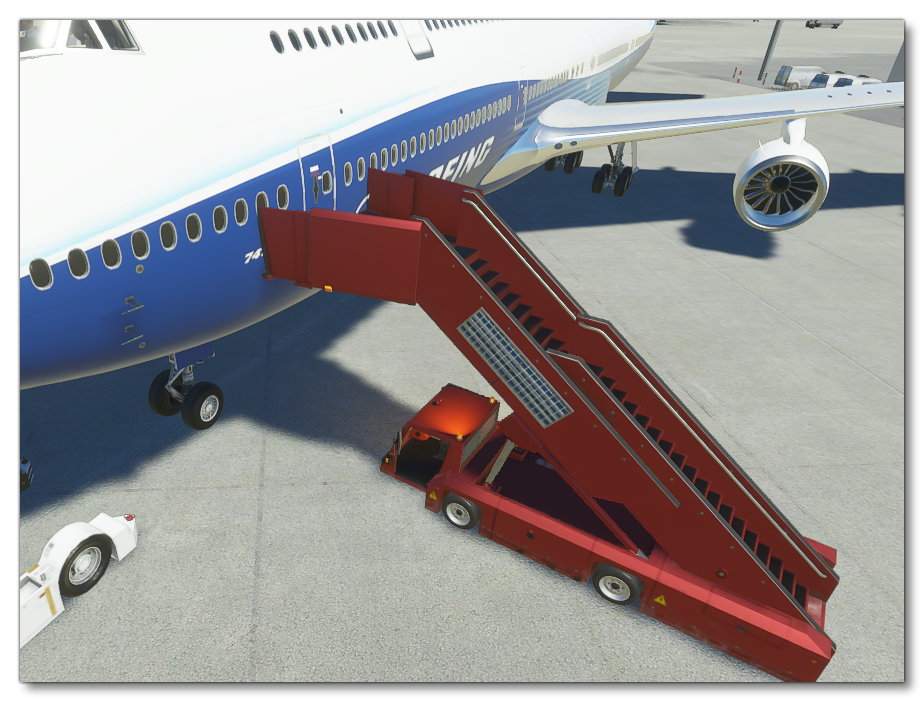BOARDINGRAMP DEFINITION
A Boarding Ramp (or Boarding Stairs) vehicle has the same parameters as other Ground Vehicles, with some additional properties. It can connect to a door of an aircraft, inclining and extended its stairs ramp in match the door properly.

Specific animations
A Boarding Ramp vehicle should have an animation that extend its stairs to reach higher altitudes. This animation should start with the stairs at its lowest point, and end at its highest point. It should also be linear in terms of altitude, meaning that the difference of altitude of the container between two consecutive frames should always be the same throughout the animation.
A Boarding Ramp vehicle can also have an animation inclining its ramp from a resting angle, to an angle adapted for boarding. The first animation, extended the ramp, assumes the ramp is at a correct angle, for its parameters (see section below).
Sim.cfg
The sim.cfg file of a Boarding Ramp must contain the following sections:
[BoardingRamp]
This section has the following two parameters:
| Parameter | Description | Type | Required |
|---|---|---|---|
top_position_when_fully_extended_YZ |
This parameter takes two values corresponding to the coordinates, in meters, of the contact point when the ramp is correctly inclined and fully extended. The coordinates are those on the vertical axis, and the back-to-front axis, respectively. |
1D table of 2 Floats (see Data Types for more information) |
Yes |
top_position_when_contracted_YZ |
This parameter takes two values corresponding to the coordinates, in meters, of the contact point when the angle of the ramp is correct, but the stairs are not extended (i.e. when the ASOBO_BoardingRamp_Elevation_Template animation is at its first frame). |
Please note that the Y coordinates (first value of both of those parameters) should correspond to the MAX_HEIGHT and BASE_HEIGHT in the ASOBO_BoardingRamp_Elevation_Template model behavior.
[TAXI]
This section is also required for the BoardingRamp ground vehicle and has the following parameter:
| Parameter | Description | Type | Required |
|---|---|---|---|
DistanceToLaneLine |
Float |
No |
Model Behavior Helper
A Boarding Ramp should use the helper ASOBO_BoardingRamp_Elevation_Template, by including "Asobo.xml". This template use the animation specified to extend the ramp to the correct height, in order to match the aircraft door height. Here is an example:
<UseTemplate Name="ASOBO_BoardingRamp_Elevation_Template">
<ANIM_NAME>Deployment</ANIM_NAME>
<BASE_HEIGHT>3.329</BASE_HEIGHT> <!-- Height of contact point relative to CG, at 1st animation frame -->
<MAX_HEIGHT>5.952</MAX_HEIGHT> <!-- Height of contact point relative to CG, at last animation frame -->
<METERS_PER_SECOND>0.2</METERS_PER_SECOND> <!-- Speed of the animation -->
</UseTemplate>Both parameters BASE_HEIGHT and MAX_HEIGHT are expressed in meters, and designate the altitude of a point relative to the center/origin point of the vehicle, i.e. the coordinates of said point on the vertical axis. This point is the contact point with the bottom of the aircraft door, this should be the ground of the last step of the stairs. Both heights assume the ramp is already at a correct boarding angle. Parameter METERS_PER_SECOND determines the speed at which the animation is played, by considering the vertical displacement of the top step.
We recommend using the ASOBO_BoardingRamp_Elevation_Template for every Boarding Ramp vehicle, because the AI will use it in order to know when the ramp has reached the correct height.
Another helper is also available, ASOBO_BoardingRamp_Orientation_Template, playing the animation inclining the ramp from a resting position to a correct boarding angle. It contains two parameters, ANIM_NAME, which is self-explicit, and PERCENT_PER_SECOND, determining the speed of this animation.
For more information please see: Ground Vehicle ModelBehavior Helpers
Note on Simvars
The individual values for the assignations of the parameters in the [BoardingRamp] section are reflected in the following simvars:
BOARDINGRAMP END POSITION YBOARDINGRAMP END POSITION ZBOARDINGRAMP START POSITION YBOARDINGRAMP START POSITION Z